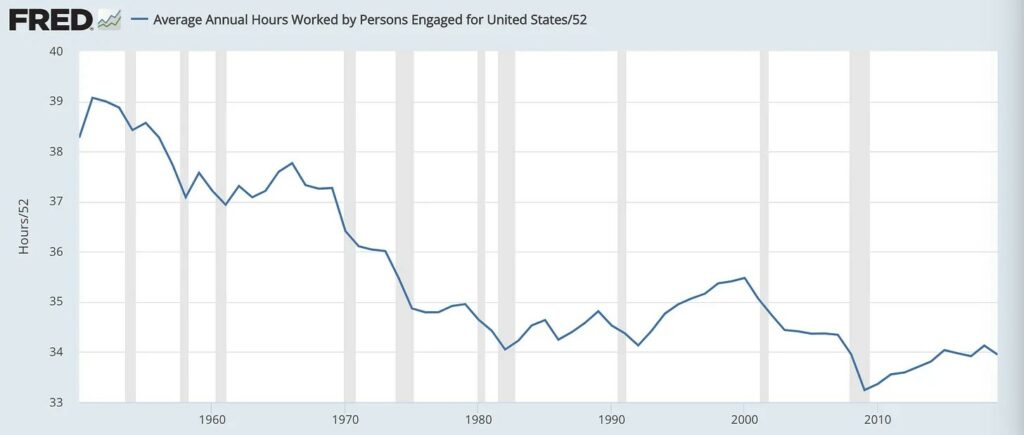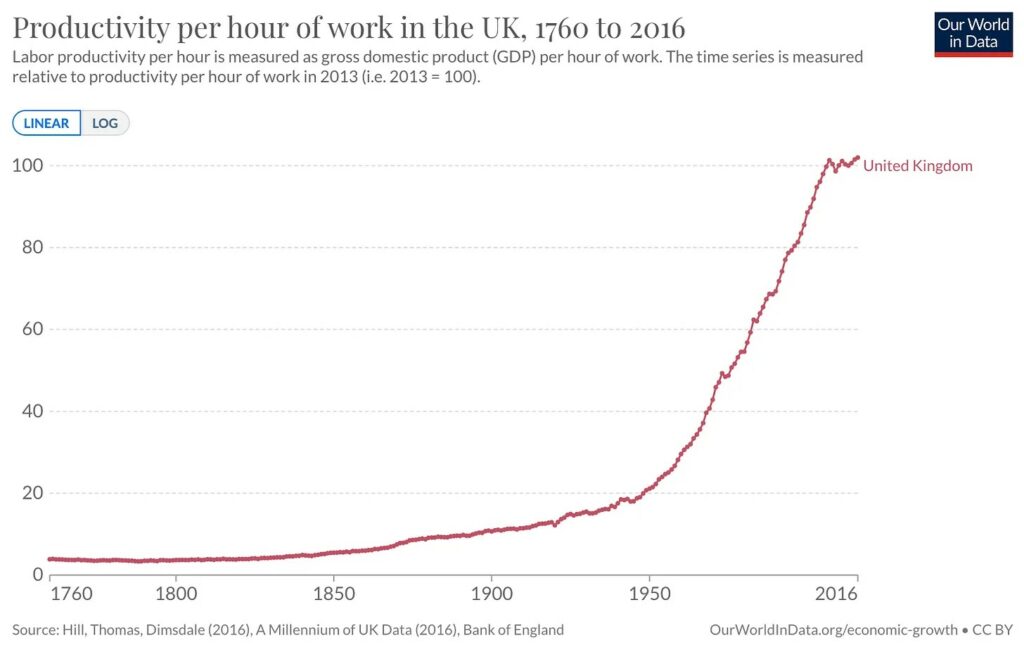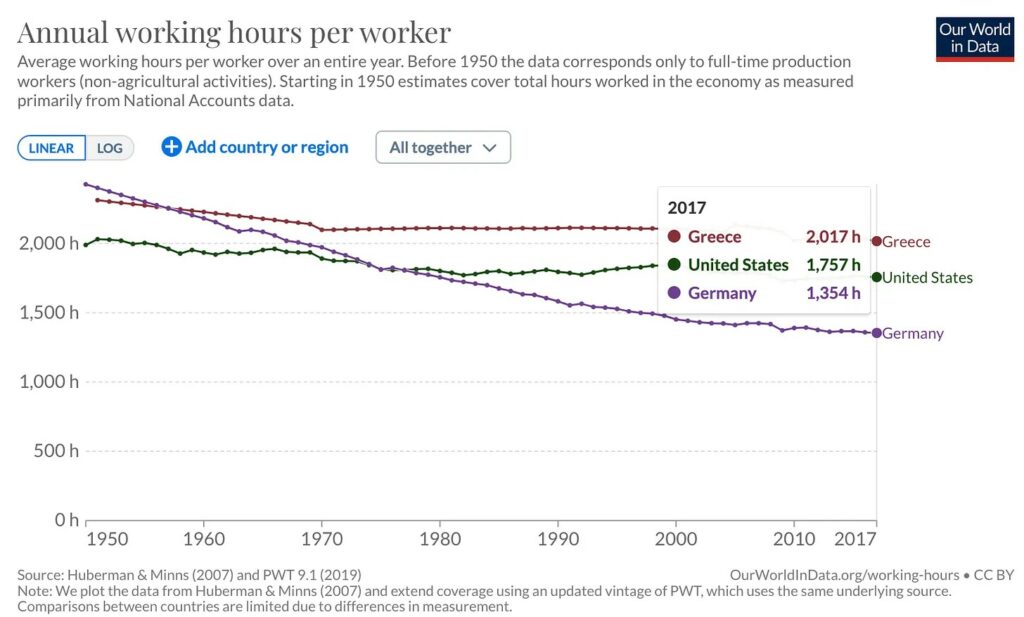Is More Work Better? Think Again?
Is More Work Better? Think Again?
The freedom of free time, branded as unproductive “leisure,” gets no respect.
Originally published at Wealth Economics
This post is prompted by a recent tweet from the excellent Joey Politano, but it’s not singling out Joey in particular.
“We could be working so much more.” It’s hard to come away with any other message. This tweet’s just one example of a lurking, largely unspoken, and quite likely unconscious value assumption that seems nearly universal among economists, pundits, politicians, and…people: more work is better.
Sure: if people need to work for wages to make a living, and they can’t get a job, that’s a bad thing. Hence the “jobs” focus of politicians and people in general. But do people work jobs because they need to, or because they want to? To some (great?) extent, it’s about need. So, we could look at the picture above, and celebrate: “Wow. Americans don’t need to work nearly as much as people in other countries. Freedom and prosperity!”
The bias is baked into economists’ very terms of art: in their lingo, the alternative to work is “leisure.” To some extent at least, it inevitably smacks of unproductive laziness. How about “free time” instead? Free time smacks of freedom. What’s not to like?
Measuring Betterness
The “great transformation” that has transfigured the world since the industrial revolution was arguably about one big thing: “productivity.” (Click for source).
This graph is slightly mislabeled; it actually shows an index of output per hour worked, which equals labor productivity (by definition).1 There’s a numerator, and a denominator. Which means increased productivity could reflect increased output (more stuff), or less hours worked (more free time). The latter is rarely considered in a positive vein.
In a more freedom-friendly view of work-life balance, there’s real value in extra time with family, friends, and loved ones, and time doing the things we love. It’s something we should seek and celebrate. Family values!
So how do different countries compare through this lens? To keep it simple, here are just three cherry-picked countries as examples. Click the image to choose your own.
The average German worker has ten extra weeks of free time every year (400 hours) compared U.S. workers. Got freedom, much? (You can see details of “annual leave” by country here.)
It’s arguably even more interesting to look at hours worked per capita instead of per worker.2 Effectively, this measures how much an average person or average family works over the course of their whole lives. Think: early adulthood, higher ed, raising children, retirement, caring for elders, and just hours, weeks, months, or even years off in “prime working [and child-rearing] age.”
Average hours worked per year over a lifetime, based on 2019 hours/capita
U.S.: 851
Greece: 804
Germany: 747
Over an 80-year lifetime, the average German works four years less than an American. (If we assume 2,000 hours is a full year’s work.) That’s a lot of life. It’s no kind of absolute measure of “goodness,” but it’s worth considering those four years compared to the extra square feet, cubic inches, diagonal inches, and just accumulated dollars that we claim instead. Is more work better?
Is Free Time “Productive”?
There’s yet another skew in all these measures, which almost never gets discussed. Do people produce “output” in their free time, or is it all unproductive “leisure”? Feeding the family, painting your mother’s house, volunteering, etc. etc.? In national accounts’ output/GDP measures, it doesn’t count. It’s outside the “production frontier,” which is defined as production involving compensation/paid work. If you don’t get paid for it, it’s not output. But consider: how “productive” would a country be without all that home work?
Back in 2009 I did a rough calc of homework — categories of Americans’ time-use that most of us would agree are productive. Including that work in GDP at the median wage would increase GDP by 33%. In other words, 25% of GDP is invisible in the U.S. GDP measure of “output.” Two years later I was pleased to be supported by far more professional research, on global time use.
Including home-work in GDP “raises the level of G.D.P. 39 percent in 1965 and 25.7 percent in 2010.”
Countries where people have more free time presumably also have a larger share of “invisible” output. So even judging by these strictly numeric measures, free time deserves a lot more respect from economists, and national accountants.
It’s Holiday Time
For me, that kind of full-throated celebration of free time is most wonderfully expressed in one of my favorite movies. It’s the best “holiday” movie ever, which I watch with my loved ones almost every year in our free time between Christmas and New Year. If you haven’t seen it yet and still have a first viewing ahead of you, I’m jealous. Enjoy! (Clip: 2.41). Unfortunately, I can not add this clip at this time.
Notes:
1 There’s a whole other conceptual and empirical mare’s nest related to “capital” and “total-factor” productivity measures, that I won’t address here.
2 This measure is just not available out there, but it’s easy to calculate: Average annual hours worked per worker x workers / population.







Steve Roth
thank you for this. it is important. maybe you will start a conversation.
i suspect “paid work” is only what counts because employers keep (my estimate) about half of what employees make. paid work also generates taxes…which is how the government pays for things we need and can’t do ourselves. and paid work also represents military production potential, and may even create the private sector output that makes “free time” possible.
i suspect your analysis of available free time also suggests we don’t need to worry about the great big horrible lack of workers to support the growing number of retired people (because they are living longer).
it might also be a threat to the reserve army of unemployed that assure boss’s ability to control the wages they offer to workers.
just conversating.
put slightly differently: paid work by others is what makes the rich rich. which is what “economics” is all about.
At least for the last half of its existence, the GDR did a better job of respecting work-life balance than the FRG. In spite of the privations, many former GDR citizens lamented the loss of mandated vacation time and day care after reunification.
joel
forgive me. this is one of my general complaints against the world that we have: if you have to use abbreviations, make sure you have identified their meaning fairly recently in your essay, or a writing for an audience that uses them routinely.
this complaint may just arise from my not so good memory, but i suspect a lot of people you want to hear what you say have memories (not fond ones) almost as bad as mine.
i think you are probably talking about east and west germany, i suppose if i strained i could guess which was which, but that takes all the fun out of reading.
anyway, if i guessed right, i would have to ask, would the people concerned blame their poverty relative to the other side, on their free time?
in America we have the work ethic: “work or die” even if you can’t find a job. our two great Parties both subscribe to this ethic, though one of them is more willing to feed the starving, subject to rigorous means testing, of course.
meanwhile those who are lucky enough to find steady work have more money than those who can’t. this makes those who can’t believe with all their souls, that the remedy is to take the money away from those who did. it’s what makes the world go round. and round and round…
I’ve grown accustomed to googling abbreviations when necessary.
These I happen to know. FRG – Federal Republic of Germany (aka West German, back in the day); GDR – German Democratic Republic (East Germany, the one with the wall, to keep out the folks trying to get in, maybe.)
East of West Gemany, as I recall, there was the catch-phrase “We pretend to work, and they pretend to pay us.”
@Fred,
“East Germany, the one with the wall, to keep out the folks trying to get in, maybe.”
LOL! No, it was to keep GDR folks from trying to get out. Preventing the brain drain to the west.
You’d think that leisure time would be the ultimate economic product. Perhaps we should be looking at hours of leisure time per hour of work time as a societal metric.
Just out of curiosity, what was the movie?
Dobbs
thanks for the look-up. i am too old to Google.
otherwise it looks like we all agree. except the economists and the Republicans.
i think we have a fear of “freeloaders” people who could work but prefer welfare..that is live off our work. not sure how many of those there are. i am fairly sure that most people like to work…just not for “the boss.”